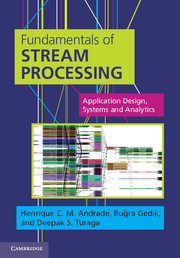Book contents
- Frontmatter
- Dedication
- Contents
- Preface
- Foreword
- Acknowledgements
- List of acronyms
- Part 1 Fundamentals
- Part II Application development
- Part III System architecture
- 7 Architecture of a stream processing system
- 8 InfoSphere Streams architecture
- Part IV Application design and analytics
- Part V Case studies
- Part VI Closing notes
- Keywords and identifiers index
- Index
- References
8 - InfoSphere Streams architecture
from Part III - System architecture
Published online by Cambridge University Press: 05 March 2014
- Frontmatter
- Dedication
- Contents
- Preface
- Foreword
- Acknowledgements
- List of acronyms
- Part 1 Fundamentals
- Part II Application development
- Part III System architecture
- 7 Architecture of a stream processing system
- 8 InfoSphere Streams architecture
- Part IV Application design and analytics
- Part V Case studies
- Part VI Closing notes
- Keywords and identifiers index
- Index
- References
Summary
Overview
In this chapter, we switch the focus from a conceptual description of the SPS architecture to the specifics of one such system, InfoSphere Streams. The concepts, entities, services, and interfaces described in Chapter 7 will now be made concrete by studying the engineering foundations of Streams. We start with a brief recount of Streams' research roots and historical context in Section 8.2. In Section 8.3 we discuss user interaction with Streams’ application runtime environment.
We then describe the principal components of Streams in Section 8.4. We focus on how these components interact to form a cohesive runtime environment to support users and applications sharing a Streams instance. In the second half of this chapter we focus on services (Section 8.5), delving into the internals of Streams' architectural components, providing a broader discussion of their service APIs and their steady state runtime life cycles. We discuss Streams with a top-down description of its application runtime environment, starting with the overall architecture, followed by the specific services provided by the environment.
Finally, we discuss the facets of the architecture that are devoted to supporting application development and tuning.
Background and history
InfoSphere Streams can trace its roots to the System S middleware, which was developed between 2003 and 2009 at IBM Research [1, 2, 3, 4, 5, 6, 7, 8, 9, 10, 11, 12, 13]. The architectural foundations and programming language model in Streams are based on counterparts in System S.
Information
- Type
- Chapter
- Information
- Fundamentals of Stream ProcessingApplication Design, Systems, and Analytics, pp. 218 - 272Publisher: Cambridge University PressPrint publication year: 2014
